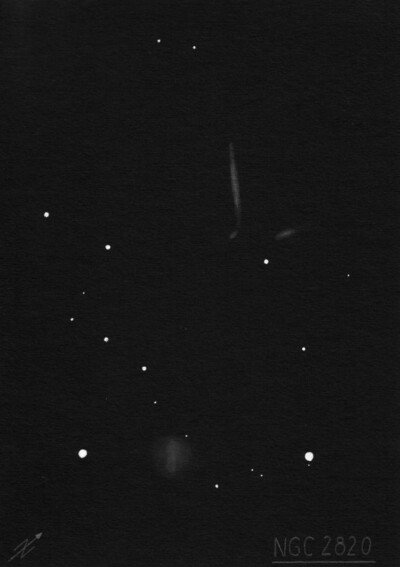
William Herschel discovered NGC 2820 = H II-869 on 3 Apr 1791 (sweep 1004) and recorded both as "Two nebulae. The first [NGC 2814] F, S, iF, the second [NGC 2820] F, pL, E. The place is that of the second, the other precedes it about 30 seconds and is nearly in the same parallel." Dreyer equated John Herschel's observation of h576 with H II-869 = NGC 2820, but his sweep data (checked by Wolfgang Steinicke) reveals h 576 = H II-868 =[NGC 2814. In addition, h579 = NGC 2816 is identical to NGC 2820, with John Herschel making a 3 3/4 error in reducing the position for h579. IC 2458, found by Guillaume Bigourdan on 14 Mar 1899, refers to the northeastern end of this galaxy and not the close companion NGC 2820A off the southwest end that is generally identified as IC 2458.
400/500mm - 17.5" (4/6/91): fairly faint, very thin edge-on 6:1 SW-NE with tapered ends, fairly low surface brightness, no noticeable core. Forms a contact pair with NGC 2820A 20" off the southwest tip. The companion is very faint, very small, elongated 2:1 SW-NE, very small brighter core. NGC 2820 is in a group with NGC 2814 4' W and NGC 2805 13' SW.
600/800mm - 24" (2/22/14): fairly bright, very large, very thin edge-on 7:1 WSW-ENE, ~2.8'x0.4', very weak concentration, mottled appearance though the surface brightness is not high. NGC 2820A dangles just south of the west-southwest edge. It appeared faint, small, oval 3:2 SSW-NNE, 18"x12", occasional stellar nucleus. NGC 2814, a smaller edge-on, lies 3.7' W.
Notes by Steve Gottlieb